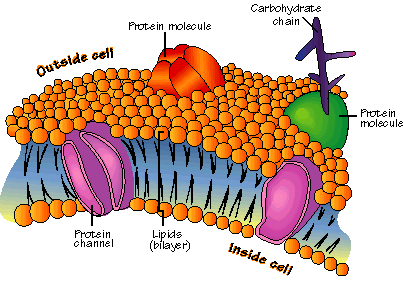Selective Permeability: Allows some substances to cross it more easily than others.
A phospholipid is an amphipathic molecule, meaning it has both a hydrophilic region and a hydrophobic region.
Fluid Mosaic Model: The membrane is a fluid-structure with a “mosaic” of various proteins embedded in or attached to a double layer (bilayer) of phospholipids.
The Fluidity of Membranes:
Membranes are not static sheets of molecules locked rigidly in place. A membrane is helped together primarily by hydrophobic interactions, which are much weaker than covalent bonds.
Most of the lipids and some of the proteins can drift about laterally – that is, in the plane of the membrane. It is quite rare; however, for a molecule to flip-flop transversely across the membrane, switching from one phospholipids layer to the other; to do so, the hydrophilic part of the molecule must cross the hydrophobic core of the membrane.
The lateral movement of phospholipids within the membrane is rapid. Proteins are much larger than lipids and move more slowly, but some membrane proteins do drift. A membrane remains fluid as temperature decreases until finally, the phospholipids settle into a closely packed arrangement and the membrane solidifies, much as bacon grease forms lard when it cools. The temperature at which a membrane solidifies depends on the types of lipids it is made of.
The solid cholesterol, which is wedged between phospholipids molecules in the plasma membranes of animal cells, has different effects on membrane fluidity at different temperatures. At relatively warm temperatures, the body temperatures of humans, cholesterol makes the membrane less fluid by restraining the movement of phospholipids.
Because cholesterol also hinders the close packing of phospholipids, it lowers the temperature required for the membrane to solidify. Thus, cholesterol can be thought of as a “temperature buffer” for the membrane, resisting changes in membrane fluidity that can be caused by changes in temperature.
When a membrane solidifies, its permeability changes and enzymatic proteins in the membrane may become inactive – for example, if their activity requires them to be able to move laterally in the membrane. In many plants that tolerate extreme cold, such as winter wheat, the percentage of unsaturated phospholipids increases in autumn, an adaptation that keeps the membranes from solidifying during winter.
Movement of Phospholipids: Lipids move laterally in a membrane, but flip-flopping across the membrane is quite rare.
Membrane Fluidity: Unsaturated hydrocarbon tails of phospholipids have kinks that keep the molecules from packing together, enhancing membrane fluidity.
Cholesterol Within the Animal Cell Membrane: Cholesterol reduces membrane fluidity at moderate temperatures by reducing phospholipid movement, but at low temperatures, it hinders solidification by disrupting the regular packing of phospholipids.
Integral Proteins: Penetrate the hydrophobic core of the lipid bilayer. Many are transmembrane proteins, which completely span the membrane. The hydrophobic region of an integral protein consists of one or more stretches of nonpolar amino acids.
Peripheral Proteins: Not embedded in the lipid bilayer at all; they are appendages loosely bound to the surface of the membrane, often to the exposed parts of integral proteins.
Six Major Functions Performed by Proteins of the Plasma Membrane:
- Transport: A protein that spans the membrane may provide a hydrophilic channel across the membrane that is selective for a particular solute. Other transport proteins shuttle a substance from one side to the other by changing shape. Some of these proteins hydrolyze ATP as an energy source to actively pump substances across the membrane.
- Enzymatic Activity: A protein built into the membrane may be an enzyme with its active site exposed to substances in the adjacent solution. In some cases, several enzymes in a membrane are organized as a team that carries out sequential steps of a metabolic pathway.
- Signal Transduction: A membrane protein may have a binding site with a specific shape that fits that shape of a chemical messenger, such as a hormone. The external messenger (signal) may cause a conformational change in the protein (receptor) that relays the message to the inside of the cell.
- Cell–Cell Recognition: Some glycoproteins serve as identification tags that are specifically recognized by other cells.
- Intercellular Joining: Membrane proteins of adjacent cells may hook together in various kinds of junctions, such as gap junctions or tight junctions.
- Attachment to the Cytoskeleton and Extracellular Matrix (EXM): Microfilaments or other elements of the cytoskeleton may be bonded to membrane proteins, a function that helps maintain cell shape and stabilizes the location of certain membrane proteins. Proteins that adhere to the ECM can coordinate extracellular and intracellular changes.

